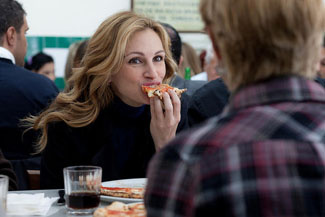Book vs. Movie: Eat Pray Love
By Russ Bickerstaff
August 18, 2010
Gilbert gets a book deal to travel to Italy, India and Bali thanks to a generous advance from a publisher who wants to publish a book about it. As few people have that kind of opportunity during a divorce, the very premise of the book serves to counteract any sympathy one may feel with the author. She eats really good meals in Italy and studies Italian. She prays in India. She spends some time with a guru in Bali. The thrust of the narrative is somewhere between journalistic travelogue and self-absorbed memoir. Neither one completely takes over the course of the book, but it’s really difficult to completely enjoy the travelogue when the author constantly interrupts to look in the mirror and it’s difficult to get completely lost in the author’s struggle when she’s spending so much time as a travel writer.
And while a great many people seem to have come to identify with the book, it’s difficult to say whether it will be remembered very well beyond the pop culture contemporary moment of the next few years (or months.) It lacks the purity of similarly inspirational works like Zen and the Art of Motorcycle Maintenance or Siddhartha. The novel is so specific to Gilbert and her problems that its overall impact and universality are compromised. And all in all, the book is really nothing new beyond Gilbert’s personal struggles. There’s a really important truism that the author seems to have overlooked. The problem Gilbert has here is common to all of the most amateurish writing, whether it be a sixth grader’s break-up poem or a best-selling novel. Any writer loves putting one word after another. The process can be quite enjoyable, but it’s quite easy to lose track of an audience.
Through her numerous commercial successes, Gilbert seems to have forgotten that Just Because Something Happened To You Does Not Automatically Make It Interesting. The big flaw with this criticism of Gilbert is, of course, the fact that enough people have found it interesting to make it a best-seller that’s being turned into a big-budget motion picture. Judging from its textual make-up, however, it seems destined to be forgotten as pop culture climbs into the next decade. Autobiographical works tend to be much more enduring when the author has accomplished something beyond the autobiography. We’re still waiting for more from Gilbert - something that isn’t at least partially self-absorbed…and, in and of itself, being self-absorbed is not necessarily a bad thing. The problem with Eat, Pray, Love is that it aggressively lacks any meaningful insight into the nature of self-discovery amongst the wealthiest people on the planet at the dawn of the 21st century. The lengths to which people go to try to find themselves can be interesting, but Gilbert doesn’t spend enough time away from the mirror to provide any kind of insight into her own experiences. As a result, the book is pretty lifeless.
The Movie
The film features 43-year-old Julia Roberts as 32-year-old Elizabeth Gilbert. Roberts has a screen presence that absolutely exudes affability. Director Ryan Murphy (who is also credited with work on the screenplay) seems to recognize this and let an audience’s natural tendency to like Julia Roberts take over. It works surprisingly well.
Continued:
1
2
3




